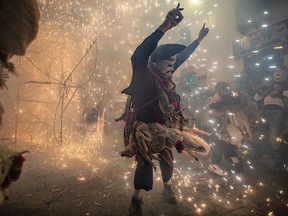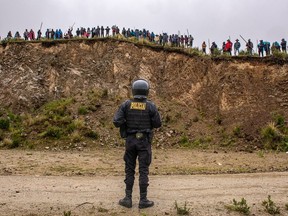For Michael Bednar, a Sarnia expat photographer interested in how culture and the environment intersect, understanding Spain’s lasting impact on Peru’s Indigenous population has proven a major project.

For Michael Bednar, a Sarnia expat photographer interested in how culture and the environment intersect, understanding Spain’s lasting impact on Peru’s Indigenous population has proven a major project.
Advertisement 2
Article content
“It’s taken longer than I ever expected,” said the 54-year-old St. Pat’s graduate, visiting family and friends in Sarnia this week.
He’s spent the last two years speaking with and photographing Peru’s Indigenous Quechua people in the Andes region, he said.
His work, he said, has included cataloging civil unrest amid then-president Pedro Castillo’s impeachment and arrest in 2022, followed by protests in Lima; and the ceremonies and traditions of what he called a spiritual people, deeply connected to the Earth, fighting for their cultural survival.
Bednar recalls how he was honored as a ceremonial member in a recent Qoyllur Rit’i spiritual pilgrimage 5,000 meters up.
“I’ve made great friendships and I’m very close to some of the people that I traveled with through that religious pilgrimage,” he said, calling it “absolutely gruelling, but incredibly rewarding.”
Advertisement 3
Article content
Bednar, who’s been based in BC since moving there for post-secondary studies about 35 years ago, has a background in natural resource management and worked for Alberta newspapers as a photographer before going freelance.
He was inspired to learn more about the Quechuan story after visiting Peru in 2014.
Volunteering with medical organization Ascenta Foundation, Bednar said he recalls being in a community called Catabambas during the Yawar Fiesta, or blood festival.
The rodeo-like festival culminated in a fight to the death between a condor and a bull, with the condor strapped to the bull’s back, he said.
Symbolically, the respective Peruvian and Spanish emblems would bring the people good or bad luck, depending on the outcome, he said.
Advertisement 4
Article content
“When I learned about that festival and talked to the people and learned about how this was representative of the struggle going on, that was what I wanted to follow up on,” he said.
In 2022, he committed, he said.

His project, The Condor and The Bull, includes a look at the sometimes dueling but interconnected cultures, he said, steeped in the history that includes the Spanish arrival in the 1500s, the ensuing colonialism and Peru’s war of independence 300 years later.
Bednar is hosting a talk and showing his photos at the Polish Hall in Sarnia Saturday from 7-10 pm, Peruvian-inspired appetizers will be served.
“It’s one thing to share things on social media and online, but to express and to show the deeper stories behind the images is another thing altogether,” he said. “And to do that back in my hometown, it’s rewarding.”
Advertisement 5
Article content
People can attend by purchasing tickets for $25 at michaelbednar.com.
Prints and photo booklets will be on sale to help fund the project, he said.

The work isn’t complete, Bednar said, though he’s been recognized with People Photographer of the Year Lucie award for the project, he said. The award will be presented in Greece next week.
He’s returning to Peru in December to finish the project, he said, including focusing on mining and climate change affecting communities there.
“The glacier has been melting at a rapid rate and illegal mining there is rampant right now because there’s such a demand for resources,” he said, listing gold and lithium among the sought-after deposits in the area including Peru.
He hopes to create a photo book with the final project and exhibit it in galleries, he said.

Article content
